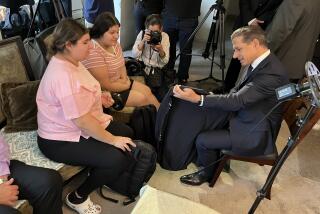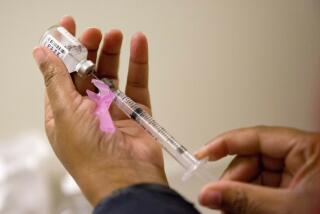When schools reopen, what happens if a student gets COVID-19? Here’s the plan in San Diego
- Share via
SAN DIEGO — As schools in San Diego County begin welcoming students back to campus, they’re also looking at when children may need to be sent home with coughs, fevers or other symptoms that could indicate a case of COVID-19.
To make those calls, school health officials are turning to a “decision tree” of COVID-19 symptoms that guides when students should be sent home and how long they must wait before returning. The step-by-step flow chart provides direction for handling COVID-19 cases on campus and summarizes guidance from national, state and local public health authorities. It applies to all schools, both public and private, said Music Watson, communications chief for the San Diego County Office of Education, which wrote the guide in collaboration with county public health officials.
“It came about because there were so many different guidelines coming out from the state and the local health department, that we made the decision to create the decision tree so it would be easier to follow when you’re at a school and in the middle of a situation,” said Corinne McCarthy, a program specialist for school nursing with the Office of Education.
Under normal circumstances, a runny nose or sore throat might simply warrant a trip to the school nurse or perhaps a day or two out of school. But conditions are far from normal, and symptoms that typically accompany a common cold or allergies could indicate a more serious coronavirus infection. Because children may present with less severe symptoms than adults, school authorities must take even mild symptoms seriously to avoid transmission of the virus to teachers, staff or medically fragile students.
“We have known for some time that we will have to send students home more often, and for longer periods of time, than ever before,” McCarthy said. “It’s really difficult. I get calls every day. We have to err on [the side of] caution now, and we send the student home.”
The decision tree starts with a list of symptoms including fever, cough, shortness of breath, sore throat, vomiting, diarrhea and changes to taste or smell. Even general maladies such as headache, muscle ache, loss of appetite or fatigue are on the list as possible COVID-19 red flags. If a student or staff member shows any of those, school officials are directed to put on personal protective equipment and isolate the person until he or she can be sent home.
There is a caveat to that protocol: If the symptoms are consistent with a person’s known chronic condition such as asthma, allergies or migraines — verified by a signed note from a primary care provider — school officials can disregard the symptoms and simply monitor the individual. If a student is not known to have such a condition, officials are advised to send the student home and direct parents to contact the child’s healthcare provider.
If the doctor or nurse orders a coronavirus test, a student who tests negative must provide proof of that result and remain home for 72 hours after symptoms resolve. If the test comes back positive, the student must remain home for at least 10 days after the onset of symptoms or the positive test. After that, the student can return to campus provided that symptoms are improving and there has been no fever for 24 hours without medication. Meanwhile, the school should notify close contacts of the student and exclude those staff members or students from campus for 14 days.
In the event of “presumed positive cases” without a coronavirus test, the school is advised to follow the same protocol as it would for a positive test result, asking the student to isolate for at least 10 days and directing close contacts to quarantine for 14 days. If the student’s healthcare provider believes the symptoms result from a chronic condition, not COVID-19, parents can provide a signed doctor’s note and the student can return to school.
The flow chart aims to provide a streamlined scenario for possible COVID-19 cases, but the county Office of Education also wrote up guidelines to explain the steps in further detail.
“There are a thousand ‘what-ifs’ and it’s really hard to get to the essential decisions that need to be made,” said Bob Mueller, a program specialist for the county office. “The goal was to help decision-makers at the school level know when they have to act and when they don’t have to act.”
Because one of the first steps is directing the student and family to their healthcare provider, school officials will be prepared to help connect them to medical care if they don’t have it already, McCarthy said.
“Part of school nurses’ role is to get kids access to healthcare,” she said. “This would be an opportunity if they don’t have healthcare to help them, to get them enrolled in Medicare. And there’s community clinics. We know how to do that, and we will help them link up to a healthcare provider.”
Another issue may be the availability of coronavirus testing for children. Existing San Diego County testing guidelines have prioritized high-risk individuals and adults, but the county is expanding testing of children, said Sarah Sweeney, a communications officer with the county’s Health and Human Services Agency.
“The county is testing those 12 and older with plans to expand that to younger children beginning with those down to kindergarten and intends to expand to even younger children in the near future,” she said. “Additionally, the state’s testing sites test children of all ages.”
The county has also worked with Rady Children’s Hospital on a system that allows any doctor to refer pediatric patients to the hospital for testing, whether they are Rady-affiliated physicians or not.
With the possibility of weeks of isolation for known or suspected COVID-19 patients, families must be aware of the prospect for disruption to school schedules, officials said. And schools must prepare to continue educating students during those absences. Individual schools may approach that differently, Mueller said, and there are no mandatory practices for instructing students who must stay home.
In some cases, Mueller said, students in isolation may be able to connect to their classes virtually in real time, seeing other students and asking questions of the teacher directly. In other scenarios, schools may ask the child’s teacher to set up individual tutoring sessions or hire a separate teacher to work with the absent student.
Mueller acknowledged it may be difficult for parents to accept extended school absences for apparently mild illnesses, but he said the protocols are designed to protect both students and adults.
Though children represent 22% of the U.S. population, data as of Aug. 3 suggest that they make up only 7.3% of all reported coronavirus cases in the country, according to the federal Centers for Disease Control and Prevention. Children are also hospitalized with COVID-19 at much lower rates than adults, the CDC reported. However, some children, including Black and Latino youths and those with preexisting conditions, are at greater risk for severe illness. Researchers are still studying the role that children and teenagers play in community transmission of the virus, and it’s not yet clear how likely they are to spread it to vulnerable family members or other adults.
“This is really hard, because many children will have very mild symptoms, and in some cases be asymptomatic, and this is going to be very hard for everyone to understand that even mild symptoms require that 10-day isolation period,” Mueller said. “The only way that we can protect each other, our workforce, our grandparents and parents is that we take these precautions. It will be a challenge.”
Brennan writes for the San Diego Union-Tribune.
More to Read
Sign up for Essential California
The most important California stories and recommendations in your inbox every morning.
You may occasionally receive promotional content from the Los Angeles Times.















